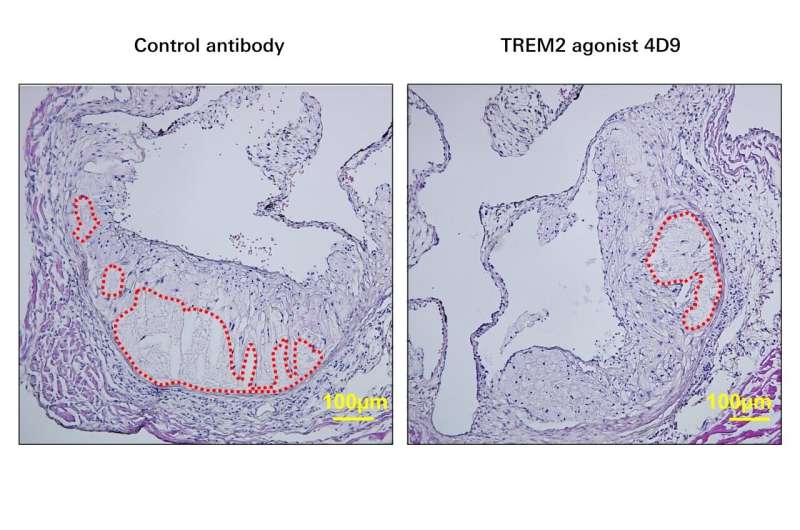This article has been reviewed according to Science X's editorial process and policies. Editors have highlighted the following attributes while ensuring the content's credibility:
fact-checked
proofread
The TREM2 antibody: A new player in atherosclerosis

A new study has investigated the mechanisms by which the receptor TREM2 affects atherosclerosis and a possible therapeutic approach using an agonistic TREM2 antibody.
Atherosclerosis is a chronic disease of the blood vessel wall. Deposits of lipids, especially cholesterol, drive the formation of plaques in the innermost layer of arteries. These deposits can narrow the interior of blood vessels and obstruct blood flow. In the worst case, they lead to blood clots, which can cause heart attacks or strokes depending on the affected part of the vascular system, accounting for about one-third of deaths worldwide.
For years, Prof. Dr. Alma Zernecke-Madsen and Clément Cochain, Ph.D., from the Institute of Experimental Biomedicine II, as well as Prof. Dr. Christoph Binder from the Clinical Institute of Laboratory Medicine at the Medical University of Vienna, have been researching this chronic vascular disease.
One focus of their research is on the immune system, which plays an important role in all stages of atherosclerosis. For example, macrophages, also known as scavenger cells of the immune system, can become foam cells by taking up lipids, which accumulate in atherosclerotic plaques.
"We already knew that these foam cells carry the receptor TREM2 (Triggering Receptor Expressed on Myeloid cells 2) on their surface and that this receptor regulates macrophage function in different pathologies such as Alzheimer's or obesity. However, the mechanisms by which the receptor affects atherosclerosis were not yet fully understood," explains Alma Zernecke-Madsen, who heads the Institute of Experimental Biomedicine at UKW.
The research groups from Würzburg and Vienna provided an important building block in their latest publication in the journal Nature Cardiovascular Research. "We independently investigated the influence of TREM2 on early and late atherosclerosis as well as on macrophage functions in two different laboratories, in Vienna and in Würzburg, which further underscores the reproducibility of the results," emphasize the three lead researchers.
Together, the researchers showed that TREM2 is crucial for macrophages in the uptake of lipids and the efficient clearance of dead cells in tissues, known as efferocytosis. TREM2 in addition promotes the survival of foam cells. By these mechanisms, TREM2 appears to control the balance between the death of foam cells and their clearance in atherosclerotic lesions.
A possible therapeutic approach was provided by studies on so-called LDLR-/- mice. Since the LDLR gene was knocked out in these mice, they have an increased concentration of LDL cholesterol in the blood, which increases the risk of developing atherosclerosis.
These mice were treated with an agonistic TREM2 antibody named 4D9, produced by Kai Schlepckow and Christian Haass from the German Center for Neurodegenerative Diseases (DZNE) in Munich, which enhanced the activity of TREM2. Stimulating TREM2 using this agonistic antibody reduced the formation of necrotic cores within the atherosclerotic plaques (see figure above).
According to Alma Zernecke-Madsen, Christoph Binder and Clément Cochain, this protective function of TREM2 could be very important, as the accumulation of dead plaque cells significantly influences the stability of the deposits and thus the clinical complications of atherosclerosis. That means: If too many cells die and the damaged cells are not efficiently removed, inflammation and subsequent harmful effects ensue. However, by administering 4D9, fewer cells die and accumulate in the necrotic core.
In addition, the researchers were able to collect data demonstrating TREM2 in and serum in atherosclerosis. "Soluble TREM2 (sTREM2) in the blood correlated with the further growth of plaques in the carotid artery of the patients," describes co-first author Dr. Florentina Porsch.
"Together with the results from preclinical animal models, this could suggest that TREM2 could be diagnostically as well as therapeutically useful, which needs to be further researched in the coming years," says co-first author Marie Piollet.
Currently, Clément Cochain, together with Alma Zernecke-Madsen and Antoine-Emmanuel Saliba from the Helmholtz Institute for RNA-based Infection Research (HIRI) with their respective research groups at the Würzburg site, are investigating the function of TREM2 in other cardiovascular diseases such as myocardial infarction and heart failure.
More information: Marie Piollet et al, TREM2 protects from atherosclerosis by limiting necrotic core formation, Nature Cardiovascular Research (2024). DOI: 10.1038/s44161-024-00429-9





















